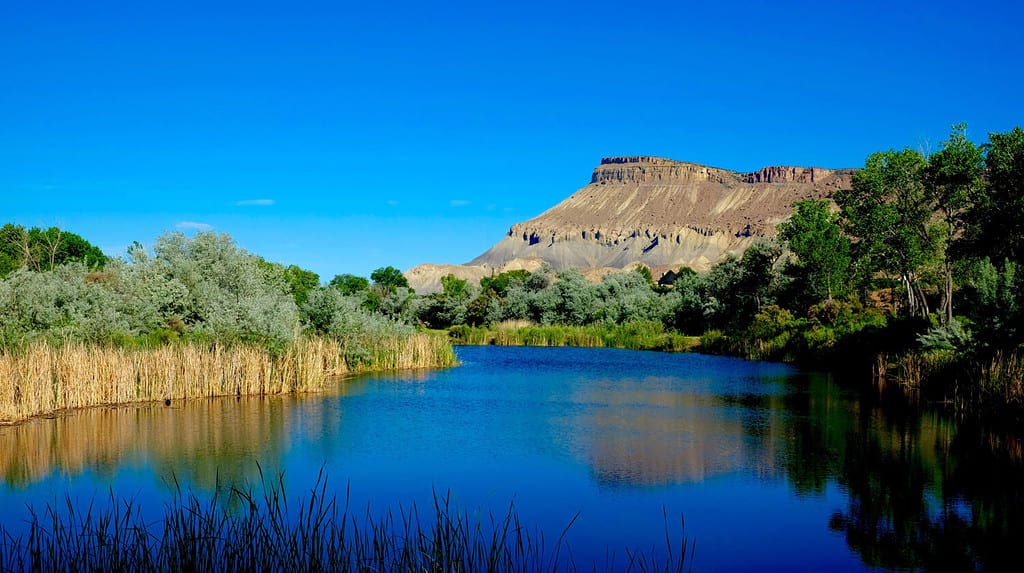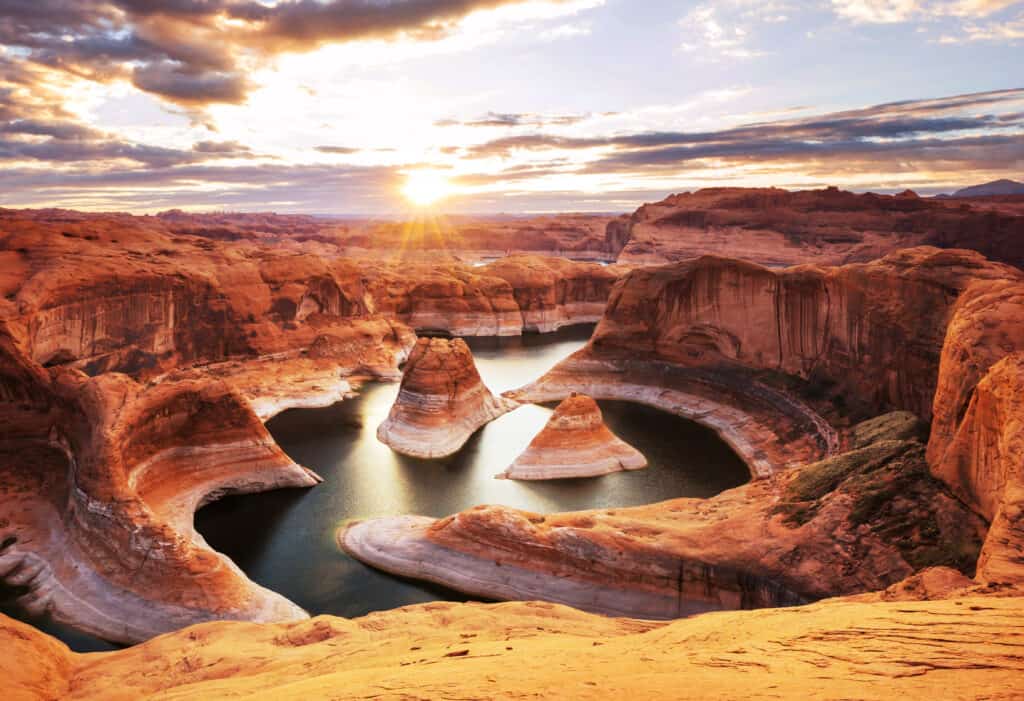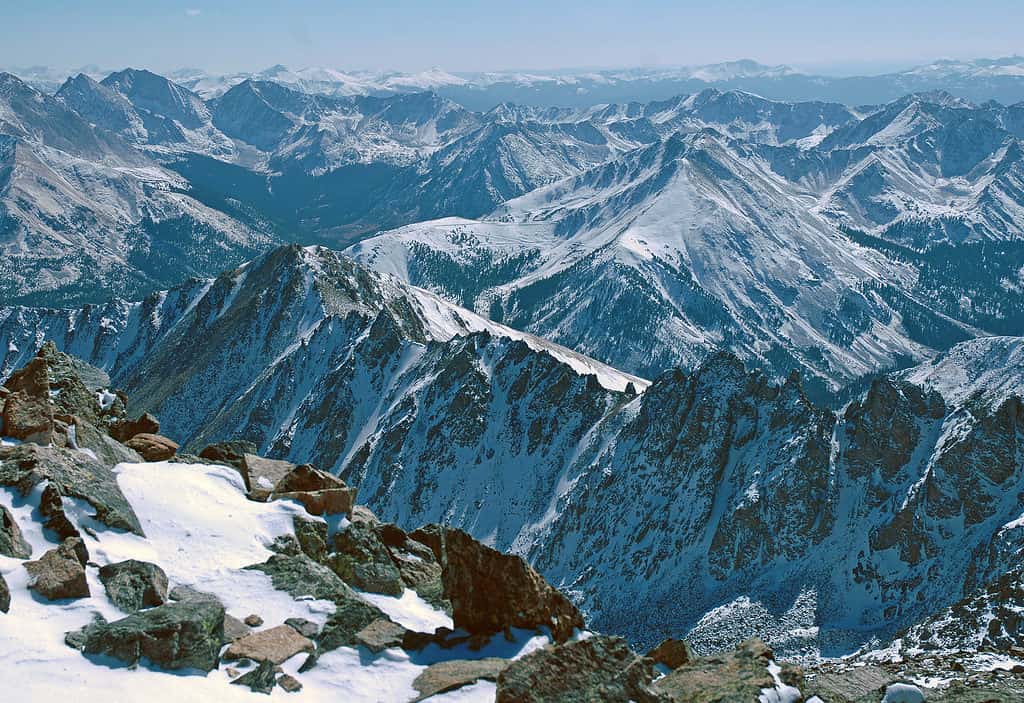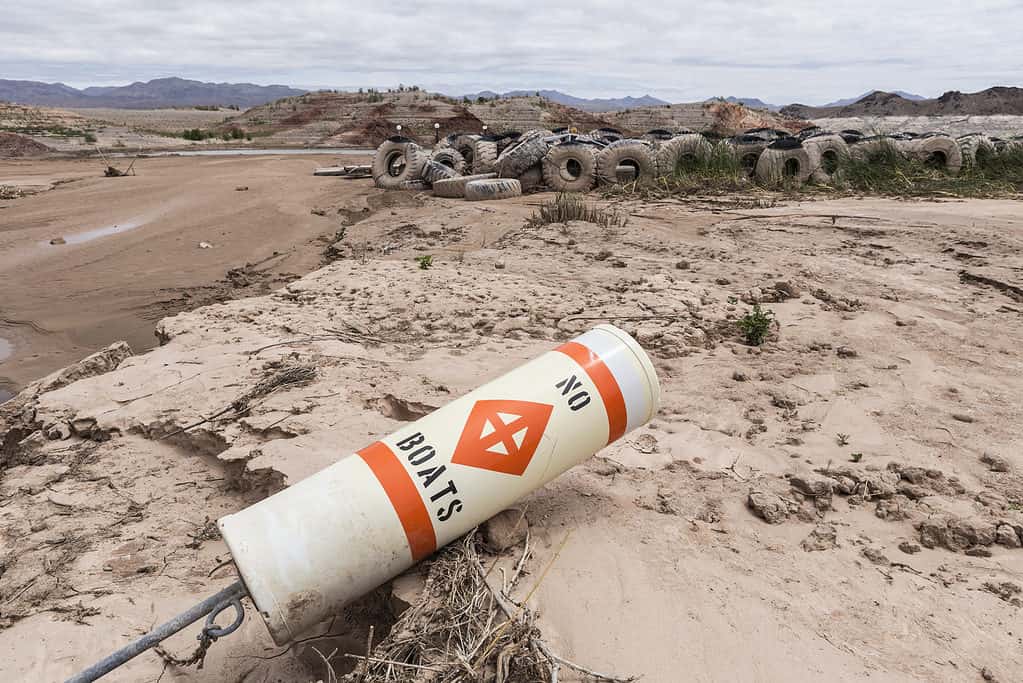Is Lake Powell Drying Up in 2023? Discover the Facts and Experts' Predictions
Lake Powell’s water levels have been dropping for 22 years. This trend is in response to the megadrought that has gripped the Western United States for more than two decades. Located along the Colorado River in northern Arizona and stretching into southeastern Utah, the reservoir’s deep blue water shimmers like a mirage within the surrounding desert. Since the beginning of the drought in 2000, however, that water has been receding, revealing an area considered to be one of the most scenic landscapes in the U.S. West.
History of Lake Powell
The Colorado River

©Jane Y/Shutterstock.com
The Colorado River Basin spans some 246,000 square miles across seven Western states. Arizona, California, and Nevada make up the Lower Basin. Colorado, New Mexico, Utah, and Wyoming constitute what’s known as the Colorado River Upper Basin. A severe, extended drought has gripped the basin and taken a toll on Lake Powell’s water levels. The period between 2000 and 2018 was the driest 19-year period over the last century and one of the driest in the 1,200-year paleo record.
The 1,450-mile-long river originates in the Rocky Mountains in Colorado. It snakes through the Western United States before disappearing into its sandy bed 80 miles from the Gulf of California in Mexico. Voted America’s most endangered river of 2023 by the nonprofit American Rivers, the Colorado River stopped flowing regularly to the sea between 1960 and 1980 as Lake Powell began to fill behind Glen Canyon Dam.
Glen Canyon Dam
Lake Powell is the second largest man-made lake in the United States. The Glen Canyon Dam created the lake on September 13, 1963, when the Colorado River started backing up against the barrier. It took 17 years for the reservoir to reach its designated full point — 3,700 feet above sea level.
The controversial dam cost $155 million to build — what would be more than $1.5 billion today — and 18 people died during construction. Built as a component of the Colorado River Storage Project (CRSP), the Glen Canyon Dam is the second-highest concrete-arch dam in the United States. It is also the largest and most strategic of CRSP facilities.
With more water storage capacity than all other storage features of the project combined, the dam stands 710 feet high, has a crest length of 1,560 feet, and contains 4.9 million cubic yards of concrete. The thickness of the dam at the crest is 25 feet and the maximum base thickness is 300 feet.
Glen Canyon Dam’s turbines can generate 1,320 megawatts of power when the reservoir is high. Glen Canyon Powerplant produces around five billion kilowatt-hours of hydroelectric power annually. The Western Area Power Administration distributes this power to Wyoming, Utah, Colorado, New Mexico, Arizona, Nevada, and Nebraska.
Along with Lake Powell’s dam, CRSP authorized the development of water management projects all along the Colorado River Upper Basin. These projects provide water storage for beneficial consumptive use, hydroelectricity, flood control, arid and semi-arid land reclamation, and recreation. They also control the flow of the Colorado River, guaranteeing the Upper Basin states of Colorado, New Mexico, Utah, and Wyoming have access to their Colorado River Compact water allotments.
Lake Powell

©Galyna Andrushko/Shutterstock.com
Lake Powell is an impressive modern marvel. At full capacity, it holds enough water to flood the state of Kentucky a foot deep. Its shoreline is longer than the entire U.S. West Coast.
The deep, narrow, meandering reservoir’s breathtaking shoreline winds 1,960 miles (when full) through ancient red rock canyons within the Glen Canyon National Recreation Area on the border of Arizona and Utah. Encompassing 1.25 million acres, the federally protected area was formed over 5 million years as the Colorado River carved through the layers of sedimentary materials making up the Colorado Plateau.
Lake Powell extends through the main corridor of Glen Canyon as well as into more than 90 side canyons that extend outward. The elevation of the lake naturally fluctuates depending on the amount of spring runoff from the mountains that flows into the Colorado River, as well as the water deliveries it makes to the Lower Basin. Each year, the reservoir’s water levels increase between May and June from the runoff. For the remainder of the year, water steadily decreases. A ring from the high-water mark is visible on the shoreline as the water level drops.
Named after Major John Wesley Powell, who led the first successful expedition to navigate down the Colorado River through the Grand Canyon in 1869, Lake Powell’s length of 186 miles makes it the second-largest reservoir in the United States. Lake Mead, hemmed in by the Hoover Dam, is the largest.
See a massive rock slide into Lake Powell.
Lake Powell Functions
According to the United States Bureau of Reclamation (USBR), which manages the reservoir, Lake Powell functions as a “vast bank account” of water. During dry years, the lake provides water storage. This storage feature allows Upper Basin states to use their share of Colorado River water while still delivering the required amount of water to Lower Basin states.
Lake Powell and the surrounding Glen Canyon National Recreation Area also provide recreational opportunities for 3 million visitors a year. Houseboats, speed boats, and fishing craft dot the reservoir’s famed turquoise water all months of the year. Visitors enjoy hiking, camping, taking scenic drives, and soaking in the area’s unique desert landscape.
Historic Water Levels
A decade of drought conditions in the West, along with withdrawals many believe are unsustainable, have caused a massive drop in Lake Powell’s water levels. The reservoir finished filling in 1980. Three years later, in July 1983, it reached the highest level ever recorded.
Historical water level data shows the lake almost reached full capacity in the late 1990s. Since that time, however, despite some spikes, Lake Powell’s water levels have been steadily decreasing. The lowest point before early 2023 was in April 2022, when the water level was down about 185 feet from its high mark.
NASA’s Landsat series of satellites documented changes in the northeastern reaches of Lake Powell in a series of natural-color images taken between 1999 and 2021. Water levels at the beginning of the series in 1999 were relatively high. From that point on, declining water levels become apparent by thinning and shortening of the side canyons feeding the reservoir.
The image from May 1, 2004, shows unmistakable evidence of falling water levels. In this image, the lake’s northwestern branch is isolated from the main reservoir. In early 2005, Lake Powell’s water levels plummeted. As the drought eased somewhat later that decade, the lake level began to rebound, although it never reached 1999 levels.
Target Water Levels
Lake Powell’s target elevation is 3,525 feet above sea level. In recent years, water levels in the lake dropped below that target elevation several times. It first dropped below this level in March 2022, and again in December 2022 before hitting a record low in early 2023 before the season’s snowpack melted into the Colorado River.
The fear among officials is that the continuing drought could cause the lake to hit dead pool, or the point that a reservoir’s water level is so low that water can’t flow downstream. Lake Powell hits dead pool levels at 3,370 feet. Dead pool would mean that water would drop below the intakes on Glen Canyon Dam’s hydroelectric turbines. This would allow air pockets to enter the equipment and damage the turbines.
While damaging the turbines could cause irreversible damage to the dam’s infrastructure, there are dangers to the water dropping to levels even before they reach dead-pool status. At minimum power pool, water can no longer produce power because it doesn’t reach the intakes for hydropower generation. At Lake Powell, minimum power pool is estimated to be 3,490 feet above sea level.
While 2022 saw many record lows, Lake Powell dropped to 22 percent capacity in early 2023. In mid-April 2023, water levels in the reservoir sunk to an all-time low at about 3,500 feet above sea level.
Current Water Levels

©Nyker/Shutterstock.com
Lake Powell and the entire Colorado River ecosystem were offered a reprieve in 2023 from the West’s devastating drought. Thanks to the historic 2022-2023 winter season, snowpack in the central Colorado Rockies peaked at 160 percent above normal.
Once all that snow began to melt and drain into the Colorado River system, Lake Powell’s water levels reversed course. According to satellite photos taken by the European Space Agency, the reservoir’s water levels surged from 3,520.81 feet in March of 2023 to 3,584.02 feet in July. Thanks to a very cold, wet winter, Lake Powell swelled by about 64 feet in four months.
To put one good year in perspective, the USBR said Lake Powell went from 23 percent to 26 percent full. However, summer heat takes its toll on desert lakes by accelerating evaporation. From its peak of about 3,584 feet after the meltwater surge, Lake Powell’s water level dropped to 3,579.9 feet on August 2, 2023.
Why are Lake Powell’s Water Levels Important?
Lake Powell’s water levels reflect the state of the larger Colorado River system. The reservoir is intricately connected to all of the infrastructure built to harness the river for human use.
Lake Mead, the next stop for Colorado River water after passing through Glen Canyon Dam, sits about 360 “river miles” downstream from Lake Powell. Lake Mead’s water levels depend on water released from Lake Powell. When water levels in Lake Powell get too close to minimum power pool, water is withheld. This creates a problem for Lower Basin states that depend on Lake Mead.
More than 40 million people depend on the Colorado River Basin for drinking water across seven states, tribal lands, and parts of Mexico. The river irrigates 25 percent of the nation’s food, the USBR reports. According to the Pacific Institute, it helps support 16 million jobs. Hydroelectric power plants located at river dams deliver electricity to 5.8 million customers.
The Colorado River Compact, signed in 1922, gave Upper Basin states a legal responsibility to deliver water to the Lower Basin. The compact apportioned 7.5 million acre-feet of water to both basins. A later treaty also promised delivery of 1.5 million acre-feet of water to Mexico. An acre-foot equals about 326,000 gallons, or enough water to cover a football field 1 foot deep.
Crisis on the Colorado River
When the Colorado River Compact was signed, water allotments were based on the expectation that the river’s average flow was 16.4 million acre-feet per year. The figure was later revised to be about 13.5 million acre-feet. Water allotments, however, did not change with the adjusted average flow figure.
As water levels in the Colorado River’s reservoirs remain below 30 percent full, many experts warn that drought conditions may become the new normal. Water lost to evaporation will increase in a hotter, dryer climate. Thirsty crops may require more water as temperatures rise. Cities that rely on the Colorado River for their water are growing. On top of rising demand, less snow is falling on the Rocky Mountains. Less snow means there is less meltwater making its way into the river.
Thousands of experts and citizens responded to the USBR’s call for input regarding the health of the Colorado River and the two main reservoirs — Lake Powell and Lake Mead. While the above-average snowfall and excessive precipitation in the spring of 2023 boosted water levels in both reservoirs, most experts believe they will never return to full capacity.
Excessive water use and the extended megadrought have compounded to create a crisis for water officials. The Colorado River has lost more than 10 trillion gallons over the past 21 years. The New Yorker called Lake Powell a “puddle of its former self,” in 2021.
Looking for Solutions
Fill Mead First
A once-controversial solution proposed by some environmental groups is called the “One-Dam Solution” or “Fill Mead First.” Once seen as a fringe proposal, citizens and farmers have joined the call to drain Lake Powell and fill the Colorado River’s largest reservoir, Lake Mead.
The Glen Canyon Institute commissioned studies analyzing the benefits to the people and ecosystems of the Colorado River Basin if Lake Powell were drained. It found that the “Fill Mead First” solution would help maintain a reliable water supply for cities that depend on Lake Mead, as well as farms across the region. It would also help restore ecosystems that were flooded when Lake Powell was filled.
The lingering drought has revealed more than 100,000 acres of formerly flooded land in Glen Canyon. The “Fill Mead First” proposal would allow the Colorado River to flow freely through Glen Canyon and the Grand Canyon.
Immediate Solutions
Water managers are looking for less drastic solutions. Six states that depend on the Colorado River signed an agreement to conserve water and improve aging infrastructure. They promised to conserve 1.5 million acre-feet of water for each of the next two years. That volume is roughly the amount lost to evaporation in Lake Mead.
The U.S. Department of the Interior announced investments for Colorado River Basin states, which should yield hundreds of thousands of acre-feet of water savings.
- $281 million for 21 water recycling projects
- More than $73 million for infrastructure repairs
- $71 million for 32 drought resiliency projects
Is Lake Powell Drying Up in 2023?

©trekandshoot/Shutterstock.com
Despite a few random spikes throughout its history, Lake Powell has been slowly drying up since it reached full capacity in 1980. The last 22 years were particularly brutal on water levels as the West’s megadrought took its toll on the Colorado River system.
Lake Powell’s elevation has dropped more than 160 feet since it was essentially full at the turn of this century. While the above-average precipitation in 2023 was a welcome relief from the drought, experts say it won’t make much of a dent in the water deficit in Lake Powell and Lake Mead.
The deficit totals 35 million acre-feet between the two reservoirs. That amount is the equivalent of a foot of water covering the entire state of New York. This year’s snowpack and melt would have to repeat for the next six years to make up the gap.
Experts warn the megadrought shows no signs of ending. Their prediction does not bode well for Lake Powell. This year’s surprising increase in precipitation gave the ailing reservoir a boost, but scientists don’t see Lake Powell rebounding anytime in the future. While Lake Powell reversed course in 2023, experts predict the drying trend will continue.









